Search the Community
Showing results for tags 'gear ratios'.
Found 6 results
-

Idiosyncratic gear ratios
Peter Nolan posted a topic in LEGO Technic, Mindstorms, Model Team and Scale Modeling
A little while ago I became interested in some slightly unusual gear ratios (for a few reasons covered below). More recently though, I gained access to a laser cutter, and hence the ability to make custom lego gears. With this in mind, I decided to work out all the possible custom gear combinations that will fit on a standard technic beam (ie all the combinations where the centre-to-centre axle distance is a whole number of studs). I found the website https://www.cailliau.org/en/Alphabetical/L/Lego/Gears/Dimensions/ handy for figuring out the meshing. I'm not sure if this is of interest to anyone else, but here is what I found: One custom gear with one standard gear (Standard gear, Custom gear, Ratio) 12 52 3/13 16 32 1/2 16 48 1/3 20 44 5/11 20 60 1/3 28 52 7/13 36 44 9/11 36 60 3/5 Two custom gears where both have a prime number of teeth (Custom gear, Custom gear, Ratio) 11 53 11/53 11 37 11/37 17 47 17/47 17 31 17/31 23 41 23/41 37 59 37/59 19 29 19/29 13 19 13/19 43 53 43/53 37 43 37/43 53 59 53/59 There are also plenty of 'loose running' combinations where the centre-to-centre distance between axles is only 0.5 mm off an integral number of studs. I tried one of these, and it seemed to work fine. Loose-running combos (standard gears in bold) (Gear 1, Gear 2, Ratio) 8 23 8/23 8 39 8/39 8 55 8/55 11 20 11/20 11 36 11/36 12 19 12/19 12 35 12/35 12 51 4/17 15 16 15/16 16 31 16/31 16 47 16/47 19 28 19/28 20 27 20/27 20 43 20/43 20 59 20/59 23 24 23/24 23 40 23/40 23 56 23/56 24 39 8/13 24 55 24/55 27 36 3/4 28 35 4/5 28 51 28/51 36 43 36/43 36 59 36/59 39 40 39/40 39 56 39/56 40 55 8/11 55 56 55/56 SO the big question is, why would I be interested in such things? The first is that a while back I built a 'phase revival' machine (video below). In this situation I wanted a ratio close to, but not exactly 1:1. In the video I used 20:24, which means that the first cog has to rotate 7776 times before all the parts line up again. If I used a custom ratio of 39:40, and had 11 modules instead of 5, it would take 10 billion years (rotating the left-most gear at 1 revolution/second) before all the pieces realigned! I'm not quite sure why, but the idea of a machine that takes the entire lifetime of our sun to reset is appealing! And now for the prime numbers... I've been interested in making lego spirographs recently, and the key to interesting patterns is the lowest common multiple of the two gears. If you have a gear with a prime number of teeth, you are pretty much guaranteed of getting lots of 'knots' in the design. In the second video below, I used a 43 tooth gear meshed with a 36 tooth gear. To actually make the gear profile, I used https://www.festi.info/boxes.py/Gears?language=en with a modulus setting of Pi (3.14) to make lego compatible gears. You also need to tweak the burn correction depending on the cutter and material. I also set 'profile_shift' to zero. I suspect that a little more fine-tuning would be required to get the best result, but this is a good starting point. I hope that someone else finds this interesting! Ahhhrrgh. I can't delete the table below! Please ignore....- 3 replies
-
- gear ratios
- custom
-
(and 3 more)
Tagged with:
-

Designing N:P (prime) Lego Technic Gear Ratios using two differentials
TechnicBrickPower posted a topic in LEGO Technic, Mindstorms, Model Team and Scale Modeling
Here I present methods for designing N:P Lego Technic Gear ratios where N and P are prime using two differentials. Several differential topologies are presented and one cross connected topology is mathematically analysed and the relationship equation between the input and output derived. Using this equation and the computer solutions for the 1:N gear ratio designs, an example is worked through to create a 313 to 421 gear ratio. This gear ratio design is much more efficient than simply connecting an N:1 and 1:P design in series. -

Using a differential to design gear ratios
TechnicBrickPower posted a topic in LEGO Technic, Mindstorms, Model Team and Scale Modeling
Hi I have been learning about gear ratio designs for a while. I have been working on understanding the differential gear mechanism. It's fascinating once you start analysing and understanding how much you can do with this amazing device. In this video I briefly talk about why and when it was invented and then go over the mathematical relationship between the axles to allow easier designs of desired gear ratios. I illustrate a design of a 17:1 gear ratio and show a list of other potential design options for creating any of the prime numbers up to 53. Of course you can probably create any prime number but will explore that in a later video. -

Computer Generated Solutions for 1:N differential gear ratios
TechnicBrickPower posted a topic in LEGO Technic, Mindstorms, Model Team and Scale Modeling
In this video I present optimal computer generated solutions for designing 1:N (N=prime) ratios using a single Lego Technic differential. Insights and ideas are shown for implementing the 1:N designs in practice using Lego Technic liftarms with an example 421:1 gear ratio device. All the possible solutions for N less than 1000 are shown and can be used in your own Lego Technic MOC designs if you are needing to create a particular gear ratio.- 4 replies
-
- differential
- gear ratios
-
(and 1 more)
Tagged with:
-

Exact 7:1 and 13:1 Gear Ratio MOC
TechnicBrickPower posted a topic in LEGO Technic, Mindstorms, Model Team and Scale Modeling
Hi Everyone. I spent some enjoyable time creating an MOC gearing mechanism that produces an exact 7:1 gear ratio and can be modified to create a 13:1 ratio. It's not that practical but shows how I converted an idea into a working model - it's never guaranteed that what you think will work actually works in practice. I think I have inadvertently created a variation of a differential gearing. -

7 : 1 Gear Ratio without a 28 tooth gear?
TechnicBrickPower posted a topic in LEGO Technic, Mindstorms, Model Team and Scale Modeling
Hi Everyone, I have made a video about creating a 7:1 gear ratio mechanism using just 2:1, 3:1 and 5:1 gears. No 28 teeth gears used. Youtube subscriptions appreciated! Kind Regards and keep building, Rob
